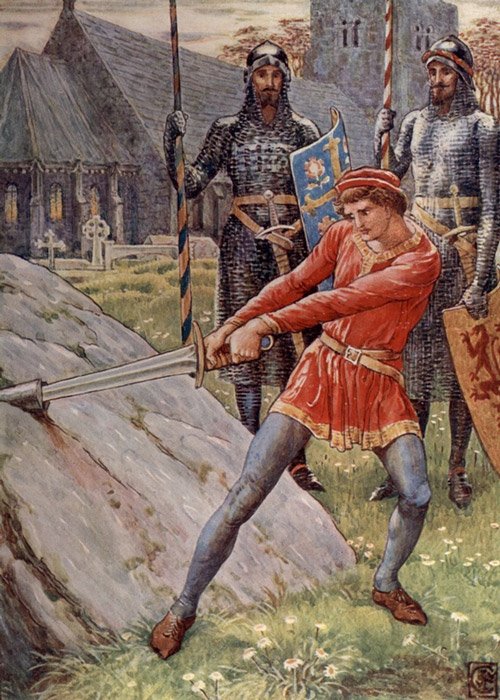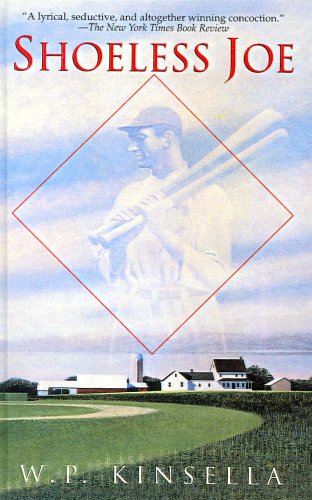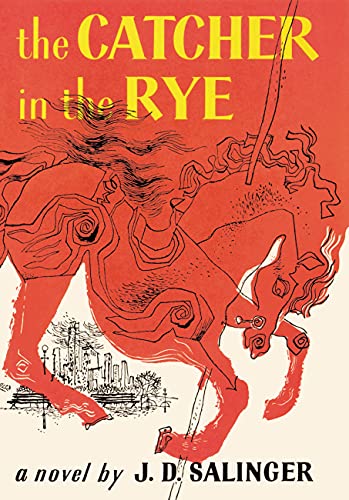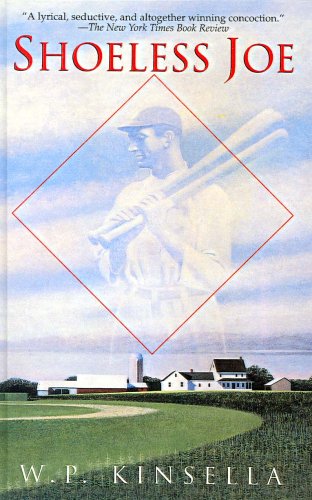Redford and Costner score with crowd-pleasing films, after novelists strike out. By Kevin Rush
The first year I followed baseball was a fantasy season worthy of the old Hollywood dream machine. The lowly New York Mets, my father’s team since returning east from grad school in 1964, pulled off the greatest miracle in professional sports history, winning 100 games en route to an upset of the heavily favored Baltimore Orioles. My dad, who’d grown up following the Brooklyn Dodgers, had suffered through two decades of disappointment before “Dem Bums” finally vanquished the “Damned Yankees” and won baseball’s ultimate prize. He looked at me celebrating and just shook his head. “Now he’ll expect this every year.” Unfortunately, no. What every Met fan my age learned at the knee of his Dodger fan father was how to say, “Wait ’til next year.”
And so, as this baseball season ends, Yankee fans are once again looking forward to the playoffs and Met fans have their sights set on Winter Meetings and Spring Training. Which is why, for us, baseball and fantasy are so intertwined. Winning, for us, is a rare, transformative, and even metaphysical experience. Our relationship to the game is a romance in the Shakespearean sense. It’s the kind of drama the two movies I’m discussing today delivered, making them hits at the box office. But how do the books they’re based on measure up?
The Natural, 1984
The Natural released in 1984 is a film imbued with wonder. I wondered if 49-year-old Robert Redford had ever played baseball before. I wondered how far he could actually hit a ball with that rusty gate swing, and why in the world director Barry Levinson would let us scrutinize its every hitch in super slow motion. But I also got caught up in a lush fable about love, destiny, and a determined soul overcoming evil. Nominated for four Academy Awards, The Natural was a pretty popcorn movie about a simpler time in sports, as uplifting as a cotton-candy sugar-high, and stayed with me about as long.

As for the book, Bernard Malamud’s 1952 debut novel is to Barry Levinson’s 1984 film what the Grimms’ fairytale Cinderella is to the 1950 Walt Disney cartoon. Walt excised a few details while sanitizing the story for a post-war American family audience. For example, in the Grimm version, the evil stepmother goes to great lengths to force her daughters’ oversized hooves into the glass slipper; she cuts the heel off of one, and lops toes off the other. The prince brings each back in turn, after the slipper fills with blood revealing the deception. A grim tale indeed. Just so, screenwriters Roger Towne and Phil Dusenberry gloss over many of the unsavory aspects of Malamud’s book, including Roy’s sexual dalliances, which are generally opportunistic and cynical. Despite Malamud’s feverish attempt to elevate the scenes of coupling with magical realism that would strain the credulity of Isabelle Allende, Roy’s sexual encounters lack any romance to stir the soul. The hero’s journey Malamud traces out for Roy takes myriad rough turns through a cynical, exploitative and corrupt world.

This seems to be Malamud’s intention. Critics have seen in Malamud’s novel parallels with Homer’s Odyssey and Arthurian legends, and have noted how his various characters reflect those in classical literature. I felt myself transported back to English Lit 101, where a deeply depressed professor stroked his graying beard as he dourly explicated Spenser’s The Faerie Queene, pointing out each of the seven deadly sins the knights of virtue encountered along their way. (Roy Hobbs plays for a team called the New York Knights.) And as with my Spenser class, I found myself crying to get out. Arcane references are fine fodder for eggheads and bookworms. The true measure of a work isn’t how deftly the author has embedded the threading of Scylla and Charybdis, but whether the book entertains on its own terms.
Levinson’s film succeeds because it serves up a gentler allegory. Using costumes, settings, and lighting—sometimes subtly and sometimes heavy-handedly—Levinson conveys a world that exists like memory on the fringes of mysticism. Redford’s Roy Hobbs is a callow youth, cruelly robbed of his life’s purpose, who returns late in life to reclaim what is rightfully his. His Roy loves the game he was blessed with supernatural ability to play, but aside from the exploding stadium lights when Roy hits his triumphant home run, the story tends more towards romance than fantasy. We, the audience, like this Roy Hobbs, despite the slightly jarring hubris that threatens to undo him, and we root for him in his struggles. It’s hard to say the same about the Hobbs of Malamud’s novel, who personifies each of the Seven Deadlies in turn, starting with pride and proceeding through greed, lust, wrath, etc. until gluttony nearly kills him. Roy is so selfish, egotistical, and grasping that he exhausts our sympathy before the seventh inning stretch.
A reader who approaches Malamud’s The Natural after seeing Levinson’s film might at least hope that the purity of baseball (the game if not the business) and a boy’s love for it would redeem the cold world in which it must be played. Sadly, that’s not the case. The beauty of the game is lost in a too long litany of wins and losses, slumps and hot streaks, where the hero ultimately falls short and walks away unfilled. Closing the book, I felt the same way.
Field of Dreams, 1989
The Natural opened the floodgates for baseball movies, so in quick succession there were Eight Men Out (1988), Bull Durham (1988) and Major League (1989). The first, I loved for the in-depth history. The second turned me off for various reasons, including its failed attempt to reconcile cinematic romantic comedy with the mores of the sexual revolution. RomComs are about the frustrated pursuit of love and the myriad obstacles overcome. When the obstacle to being with the object of your desire is the guy ahead of you banging her, who is just the latest in a long line of bangers, the bloom is off the rose. When Crash finally gets with Annie, his career is done, she’s tired of bed-hopping, and they just seem ready to settle, because their routines have worn them out. That’s not much of a payoff for the audience who’s hung with them for ninety minutes, because there’s no special trick to “getting the girl,” when the rest of the town has already had her. The film also suffered from Costner’s low-key performance, which I felt lacked charm, and a lot of way-too-obvious humor that fell flat. I know a lot of people love Bull Durham (Rotten Tomatoes has it ranked as the second greatest baseball movie of all time behind Moneyball), but upon its release, I dubbed it Dull Bore ‘em, and I stand by that assessment.
As for Major League, the trailer was so packed, I assumed it had shown all the best jokes. So since I had already seen Slap Shot, I figured I didn’t need to spend seven dollars.

But from my first glimpse of the theatrical trailer for Field of Dreams, I was hooked. Yeah, I was chagrined slightly that it starred Costner, because everything he’d done to that point including Eliot Ness in The Untouchables, had left me slightly disappointed. I did not see the onscreen magnetism of an A List movie star; I saw a tall, not so bad looking guy getting paid millions to learn how to act on the job. But the Hollywood machine seemed determined to make Costner a star, so what could I do about it? I decided to keep an open mind about Costner; I put down my seven or eight dollars and entered into the fantasy of an Iowa farmer who heard a voice telling him that “If you build it, he will come.” Costner turned out to be fine, though I still had my quibbles, but the film really spoke to me about where I was in my life: unsure what my path should be, stuck somewhere between prolonged adolescence and adulthood, and most importantly, uneasy in my relationship with my father, with whom I could not talk openly about anything except baseball. So, yes, I went along for the ride, I shared Farmer Ray’s urgency to get to the heart of the mystery, and, yes, I cried when he asked his dad to play catch.
At the time, Costner had called the film “It’s a Wonderful Life for our generation,” which seemed plausible, since I’m pretty sure many baby boomers secretly regret their youthful radicalism and yearn for reconciliation with their parents. But I don’t think Field of Dreams has held up. Whereas each viewing of Capra’s classic, tied into my celebration of Christmas, endears me further to the Bedford Falls milieu with its many well-drawn characters and the all-too-human struggles of George Baily, Field is not anchored to any recurring observance and subsequent viewings, for me at least, have simply exposed its flaws. I get impatient watching Field, annoyed that I ever let it get to me that first time, and so I don’t think I’ve ever sat all the way through a second showing. Once again, I’m sure I’m in the minority. So much so, that readers of this column might choose to disregard what I have to say about the book, but here goes anyway.
Shoeless Joe by Canadian writer W.P. Kinsella was the inspiration for Field of Dreams. Published in 1982, the novel, which won the Houghton Mifflin Literary Fellowship Award, tells the story of Ray Kinsella, an Iowa insurance salesman turned farmer, who hears the voice of a baseball announcer instructing him to turn his cornfield into a baseball stadium, because, “If you build it, he will come.”
The book is far more expansive, and dare I say meandering, than the film, featuring characters the screenwriters dropped to get a cleaner, more focused narrative. One such character is Eddie Scissons, the former owner of Ray’s farm, who bills himself as the Oldest Living Chicago Cub. Another is Ray’s identical twin Richard, whom he hasn’t seen for 15 years, since at the age of 16, he had a fistfight with their father and left home.

But the most consequential character change from the book is that Ray does not “kidnap” the fictional writer Terrence Mann, author of the radical novel, The Boat Rocker, but a fictionalized version of the real-life writer, J.D. Salinger, who wrote A Cather in the Rye. In fact, Kinsella once told The Des Moines Register that the working title of the book was The Kidnapping of J.D. Salinger. This choice creates problems for Kinsella’s narrative which he never completely overcomes. That is, the portrayal of Salinger must be human enough for the reader to believe, but benign enough so Salinger would not sue for infringement. Thus, J.D. Salinger, whose name suggests edgy and subversive, is rendered bland enough to fade into the kitchen wallpaper.
If you admire Field of Dreams, as I do, for the clarity of Ray’s internal conflict, i.e., the regret he harbors over the distance he put between himself and his father, and how they never understood each other, and how Ray has a burning desire to bridge eternity to close that gap, be aware that such clarity does not exist in Kinsella’s book. The novel’s Ray had a warm relationship with Dad. The antagonism was entirely between his twin brother Richard and the dad. Unfortunately, his pugnacious twin comes very late to the narrative, and what he might be thinking is not explored or resolved. As far as the dramatic thru-line is concerned, that character might as well not have existed. Obviously, the film’s developers felt likewise, and made the wise choice of incorporating Richard’s daddy issues into Ray’s character. However, the book, because of the lack of tension between Ray and his dad, fails to deliver the movie’s emotional pay off when the two finally meet.
Now, if you’re a fan of dramatic thru-lines generally, good luck with Shoeless Joe. The novel, at 265 pages is roughly 90 pages of fluff I could have done without. That fluff includes effusive, treacly, yet vague paeans to the love he and his wife, Annie, share. Often. Like constantly. The characters are also a bit frustrating to deal with. If you thought Amy Madigan’s portrayal of the ever-so-chipper-never-complaining-always-supportive wife lacked depth, she’s James Dean in East of Eden compared to Annie in the book. Our narrator, Ray, is a wordy son of a gun with a touch of ADHD. He’s also a far cry from Kevin Costner, who was always a hunk and has matured into a first-rate leading man with intense gravitas, as shown in some fine performances in Open Range, Yellowstone, et al. Ray in the book is very much a beta male, and we get the impression that no matter how much his hair recedes or his frame fills out, he’ll always be a beta. Here’s how Ray Kinsella describes himself:
…it’s just that I’m uncomfortable with most men, especially “men’s men,” who know all about gears, rifles, and how to splice rope. They always make me feel like the new kid on the block, tolerated but not accepted, and they always act as though they have a common secret that I will never be party to.”
It’s hard to imagine Kevin Costner ever harboring such insecurities.
But, you might ask, is Shoeless Joe at least a fun read? Well, it’s not going to hurt you. The book, as you would expect from the film, is imaginative, and at times humorous and heartfelt. But it suffers from Kinsella’s too earnest desire to construct mythology out of snippets of baseball lore laced with random Americana and bound up in weak sentiment. His narrator often (and gratuitously) expresses his disdain for religion, and it’s clear Kinsella (either Ray or W.P. or both) would like to replace church rituals with ritual attendance of baseball games. At one point “Kid” Scissons goes on a rant about baseball as “word” which more than implies a desire for baseball fanaticism to usurp the vaunted station held by sacred scripture in the public consciousness. How a diversionary pastime might form the basis for a moral society while providing a salvific vision giving hope to the hopeless is not explained in the character’s flimsy tirade. And yes, I know, this is light fantasy, so we don’t want to crush dandelion fluff under the weight of eschatological ponderings, but the writer who deliberately raises questions cannot retreat behind pleas to his readers “not to think too hard.”
Which brings us to another grating point of style, which is the weird self-referential tone that Kinsella the writer has in relation to Ray Kinsella the narrator, as though the novel is in some measure a fantasy biography that only close relations and insiders can truly appreciate. It also gives the book an aura of an all-too-precious vanity project. And precious, unfortunately, aptly describes much of the prose. So, if you are a fan of masculine writing, and approach Shoeless Joe as a baseball book, you’re going to have a tough time sifting through a seemingly endless procession of saccharine similes, as Ray tells you how something he preciously feels or observes is preciously like something else.
Still, some of the writing is quite good. There’s a wonderful passage towards the very end, a speech given by Salinger about how visitors will come from all over drawn by their dreams, that rivals the prose of Jack Kerouac, whose influence is felt throughout.
My bottom line for Shoeless Joe is that the inspiration for the story deserves a better book, and W.P. Kinsella is lucky to have gotten so good a film made from it. Today, perhaps the only use for Kinsella’s novel is to instruct would-be screenwriters on how to take a cluttered, meandering story with potential and help it find its heart for the big screen.
Disclaimer: Links in this column may be affiliate links. If you click on an affiliate link, the author receives a small commission on purchases for a limited time at no additional cost to you. These commissions help ensure future posts. Thank you.
If you’ve enjoyed this post, I invited you to read the other posts on books made into film, including two by Hitchcock and two noir-ish Bogeys.

Leave a Reply
You must be logged in to post a comment.